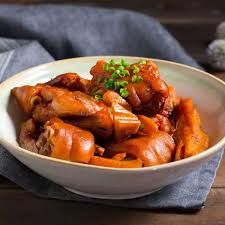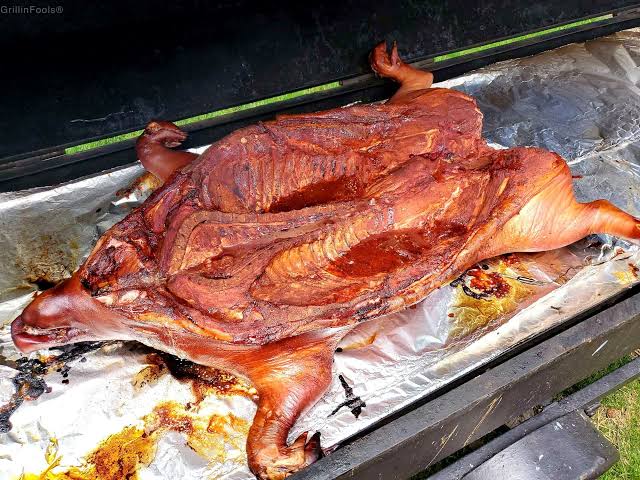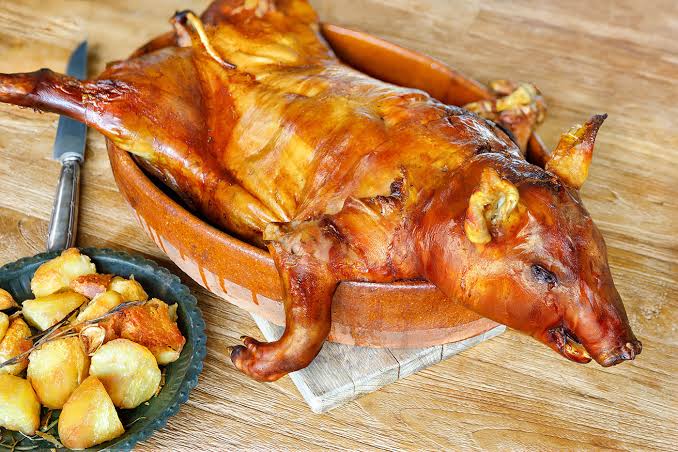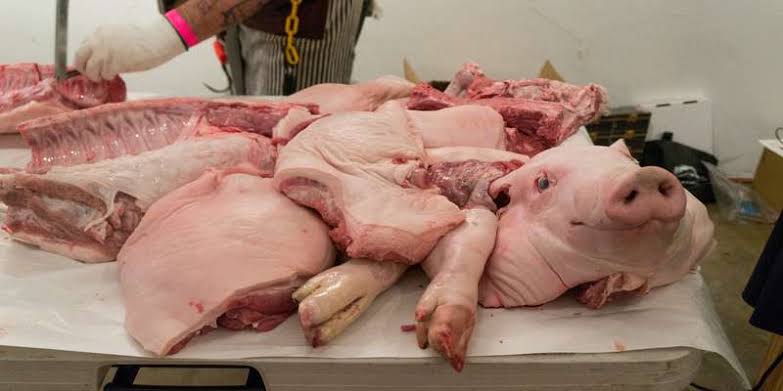Pig meat, also known as pork, is a widely consumed and versatile meat that comes from domestic pigs. People have been enjoying the delicious taste of pig meat for centuries, and it plays a significant role in various cuisines around the world.
Pig meat is prized for its succulent and tender texture, making it a popular choice for a wide range of dishes. Whether roasted, grilled, fried, or stewed, pig meat offers a delightful eating experience. The versatility of pig meat allows it to be prepared in numerous ways, catering to different culinary preferences.
One of the most common forms of pig meat is bacon, a flavorful and crispy delight enjoyed for breakfast or as a tasty addition to sandwiches and salads. The distinct smoky aroma and savory taste of bacon have made it a beloved ingredient in many households.
Pig meat is rich in essential nutrients, including protein, vitamins, and minerals. It provides a good source of energy, promoting overall health and well-being. Incorporating pig meat into a balanced diet can contribute to muscle growth, repair, and maintenance.
In addition to its nutritional value, pig meat has cultural significance in various regions. Traditional dishes featuring pig meat often play a central role in celebrations and gatherings. The preparation methods and seasonings may vary, reflecting the diverse culinary traditions passed down through generations.
Despite its popularity, the consumption of pig meat has also sparked debates and discussions regarding health concerns. It is important for individuals to make informed choices based on their dietary preferences and health considerations.
In addition, pig meat holds a prominent place in the world of culinary delights. Its versatility, rich flavor, and nutritional benefits make it a favorite among meat lovers globally. Whether enjoyed in a classic pork roast, sizzling bacon, or a comforting stew, pig meat continues to bring joy to tables and palates worldwide.
Read Also: 18 Medicinal Health Benefits Of Ground Ivy (Glechoma hederacea)
Uses of Pig Meat

Pig meat, or pork, finds diverse uses in various culinary applications, offering a range of flavors and textures for different dishes. From savory to sweet, here are some common uses of pig meat:
1. Roasts and Grilling: Pig meat is often roasted or grilled to perfection, creating succulent and flavorful dishes. Roast pork, with its crispy skin and tender meat, is a classic choice for celebratory meals.
2. Bacon: Perhaps one of the most beloved uses of pig meat, bacon adds a smoky and savory element to breakfasts, sandwiches, salads, and a wide array of recipes. Its versatility extends to being wrapped around other ingredients for a burst of flavor.
3. Sausages: Ground pig meat is frequently used in the preparation of sausages. These can be seasoned in various ways, reflecting regional tastes and preferences, and are enjoyed grilled, fried, or added to stews and casseroles.
4. Stews and Soups: Pig meat contributes depth and richness to stews and soups. Whether in a hearty bean stew or a comforting bowl of soup, pork enhances the overall flavor profile of the dish.
5. Ham: Cured and often served in slices, ham is a popular choice for sandwiches, salads, and festive occasions. Its sweet and salty flavor makes it a versatile ingredient in both hot and cold dishes.
6. Pork Chops: These are slices of pig meat cut perpendicular to the spine, often grilled, pan-fried, or baked. Pork chops are a quick and easy option for a satisfying meal.
7. Pulled Pork: Slow-cooked and shredded pig meat, commonly referred to as pulled pork, is a staple in many cuisines. It’s often seasoned with flavorful spices and used in sandwiches, tacos, or served on its own.
8. Cured and Smoked Meats: Pig meat is frequently cured and smoked to create a variety of delicacies such as smoked ham, prosciutto, and chorizo. These cured meats add depth to charcuterie boards and antipasti.
9. Asian Cuisine: Pig meat is integral to many Asian cuisines, featuring in dishes like char siu (barbecued pork), sweet and sour pork, and various noodle soups.
10. Desserts: Surprisingly, pig meat finds its way into certain sweet treats as well. In some cuisines, lard is used in pastry-making to achieve a flaky and tender texture in pies and pastries.
These diverse uses highlight the adaptability of pig meat in the culinary world, showcasing its ability to lend its distinct flavor to a wide range of dishes across different cultures and cuisines.
Read Also: 16 The Medicinal Health Benefits of Maitake (Hen of the Woods)
The Preparation of Pig Meat

Preparing pig meat is a straightforward yet rewarding process that allows for a variety of delicious dishes. Whether you’re working with pork chops, bacon, ham, or sausages, the key lies in simple techniques that enhance the natural flavors of the meat.
For pork chops, a popular cut, start by seasoning them with salt, pepper, and any desired herbs or spices. Pan-fry or grill the chops until they achieve a golden brown exterior and a juicy, tender interior. This basic method ensures a tasty and versatile main course.
When dealing with bacon, the options are numerous. For a classic crispy texture, pan-fry the slices until golden brown. Alternatively, you can bake bacon in the oven for a hands-off approach that results in evenly cooked and delightfully crunchy strips.
For ham, especially if it’s a whole ham, slow roasting is a common method. Glaze the ham with a mixture of brown sugar, mustard, and cloves to impart a sweet and savory flavor. Roast until the exterior forms a flavorful crust while the inside remains moist and succulent.
Sausages lend themselves to various preparations. Grill them for a smoky flavor, pan-fry for a crispy exterior, or incorporate them into casseroles and stews for added depth. The versatility of sausages allows for creative culinary exploration.
Regardless of the chosen preparation method, it’s essential to cook pig meat thoroughly to ensure food safety. Use a meat thermometer to check for the recommended internal temperature, which varies depending on the cut.
In addition, preparing pig meat involves seasoning and cooking methods that bring out the best in each cut. Whether you’re aiming for a simple weeknight dinner or an elaborate feast, the diverse range of pig meat provides ample opportunities for culinary creativity.
Economic Benefits of Pig Meat

The economic benefits of pig farming and the pork industry are significant on both local and global scales. Pig farming contributes to employment, income generation, and plays a crucial role in the agricultural sector.
1. Employment Opportunities: Pig farming provides employment for a substantial number of people. From farmers and farm workers to those involved in processing, transportation, and distribution, the pork industry supports a diverse range of jobs. This, in turn, contributes to rural development and livelihoods.
2. Income Generation: Pig farming is a source of income for farmers and entrepreneurs involved in the industry. The sale of pigs and pig meat, such as pork cuts and processed products, generates revenue for individuals and businesses along the supply chain.
3. Export and Trade: Many countries engage in the export of pork products, contributing to international trade. This can enhance a country’s economy by creating foreign exchange earnings. Pork exports also foster economic relationships between nations and contribute to global food security.
4. Food Security: Pig meat is a valuable source of protein, and its production helps meet the dietary needs of a large portion of the global population. As a relatively affordable and accessible protein source, pork contributes to food security by providing a staple in the diets of many people.
5. Value-Added Processing: The pork industry extends beyond primary farming to include value-added processing. This includes the production of bacon, sausages, ham, and other processed pork products. Value addition enhances the overall economic value of pig farming by creating diverse products for consumers.
6. Support Industries: The pork industry stimulates growth in supporting sectors such as feed production, veterinary services, equipment manufacturing, and transportation. These auxiliary industries create additional economic opportunities and contribute to the overall economic landscape.
7. Research and Innovation: Pig farming encourages research and innovation to improve efficiency, animal welfare, and product quality. Investments in research and development lead to advancements in breeding techniques, disease control, and sustainable farming practices, contributing to the long-term viability of the industry.
In conclusion, the economic benefits of pig farming are multi-faceted, encompassing employment, income generation, international trade, food security, value addition, and advancements in research and technology. The pork industry’s positive impact on economies underscores its significance in global agriculture and food systems.
Read Also: Hydroponics Guide 101: All You Need to Know About it

